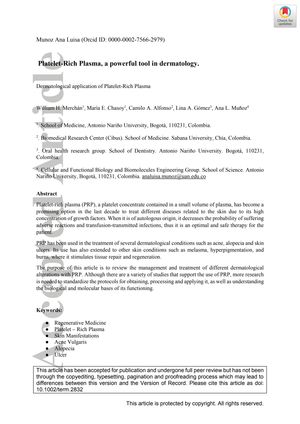Platelet-Rich Plasma, a Powerful Tool in Dermatology
February 2019
in “
Journal of Tissue Engineering and Regenerative Medicine
”

TLDR Platelet-Rich Plasma (PRP) shows promise for treating various skin conditions, but more research is needed to standardize its use.
The document from April 9, 2019, reviews the use of Platelet-Rich Plasma (PRP) in dermatology, highlighting its potential benefits for treating skin conditions such as acne scars, alopecia, skin ulcers, melasma, hyperpigmentation, and burns. PRP, which is rich in growth factors, has been shown to accelerate tissue repair and regeneration. In the context of alopecia, studies demonstrated PRP's effectiveness in promoting hair growth and increasing hair density, with one study showing positive results after three injections every twenty days and a final boost at six months, and another treating 24 patients with increased hair density after four sessions. PRP also showed promise in treating skin ulcers and in skin rejuvenation, improving skin vitality and collagen levels. For melasma and periorbital hyperpigmentation, results were mixed, with some studies showing significant improvement and others showing no significant difference. In burn treatment, PRP may enhance cell repair, although a human study with 52 patients showed better epithelialization but no significant difference in scar quality after one year. Despite these positive outcomes, the document stresses the need for more high-quality research to standardize PRP protocols and confirm its efficacy across various dermatological applications.












